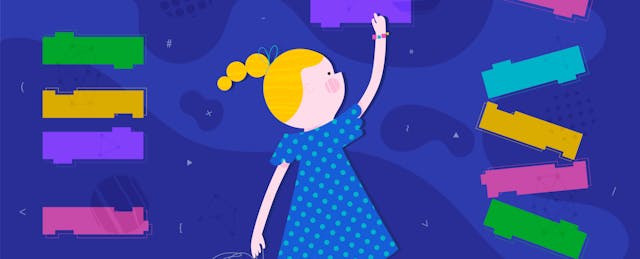Congrats, Mr. Principal, on your middle school’s new STEM curriculum. I hear the kids are going to make a robot move to the right, stop, and turn around. How cool is that?
The reality: It’s not that cool.
There’s an outsized focus today on science, technology, engineering and math, known as STEM (or STEAM if you prefer to include “arts”) and for good reason. Much evidence suggests our children’s careers, future industries, and our country’s prosperity will increasingly be shaped by these academic areas. So, why are the kids playing games?
Today, K-12 coding education offerings often include edutainment: some brand’s robotic-design, game-design and app-design program, packaged as engaging, entertaining experiences for students. After all, shouldn’t learning be fun?
It’s no surprise kids do indeed have fun with these products, and they also appeal to educators. In many schools, few teachers can teach coding. So, having no idea where to begin a curriculum, they turn to so-called experts: companies that sell them products to meet new coding or STEM requirements. To be clear, this isn’t a case of lazy teaching or administration. It’s a knowledge deficiency that can lead schools—and in turn, students—in the wrong direction.
Unfortunately, dragging and dropping is not coding, and don’t even think about taking on robotics until you’ve learned to code. Sure, some forms of edutainment are beneficial. That adorable program may help little Brandon and Zoe learn arithmetic or bolster their vocabulary, but when it comes to coding, there simply is no replacement for digging in and doing the work. Everything your school wants to accomplish in coding should focus on people and actual coding.
This, I learned the hard way.
In 2002, I founded a summer coding camp, SummerTech, located on the campus of Purchase College, SUNY. For the first couple of years, I confess, we used edutainment programs. The kids had plenty of fun. For most of them, however, that wasn’t their real motivation; learning was, and we didn’t feel we were making much progress. They wanted to become real-life coders and they weren’t headed in that direction.
So, we found another, much more effective way. We turned to the kids themselves.
Having previously leaned toward large-group lectures, we began using small groups to teach straight coding to our campers. Eventually, they gained enough proficiency to teach other kids what they themselves had learned, spawning a circular coding community that grew each year. Next summer, we’ll have about 700 campers led by about 70 student-teachers, most of whom were once our campers. And many former campers are now professional coders at top technology companies.
The takeaway: the coding apps and games weren’t a vital element of learning. Rather, it was the small-group conversations that were taking place. Kids, deeply engaged with just a few other kids, including a leader who wasn’t much older than them. True role models. It made the experience much more meaningful than any consumer program could.
School administrators have the power to create the same environment, making a distinct impact on a district’s educational trajectory.
Today in America, there are tens of thousands of proficient, college-aged computer science students. It’s likely many are in close proximity to you. Some of them may well be capable—and interested—in being the next coding educators for your students, who in turn can grow into teachers themselves.
This is what we’re doing in Hoboken, New Jersey. Coditum, SummerTech’s Hoboken-based coding lab, earlier this year joined forces with Hoboken Middle School. We hired computer-science students from Stevens Institute of Technology in Hoboken to teach HMS students, who in turn may become junior instructors themselves once they reach high school.
The HMS program will continue to feed itself, creating an increasingly vibrant, STEM-focused collective. In short order, middle schoolers will learn to code on a college level. The bar is rising and the skills young teachers gain—leadership, confidence, crystallization of knowledge, time management—are as valuable as coding itself.
So, how can you, an administrator, put a similar plan in place if you don’t have a coding background? For starters, know that I was once you: ambitious to introduce STEM to kids without much of a background in it. Here are some suggestions on building a program.
- Find coders. Identify local college computer-science programs and hire students who know how to code. Like the ABCs or 123s, coding basics are just that: basic. Coding is coding as piano is piano, or baseball is baseball. There are rules to follow and you need to learn those rules from a good coach, not a game. You may also find success in identifying parents who are developers, seeking their support in leading a coding club or program.
- Equipment. Early coding can be done on any computer more powerful than a Chromebook. Don’t use tablets. Simple laptops around $500 have all the capability you require.
- Small groups. Asking a college kid to stand in front of a dozen or more students and teach won’t work. That’s tough enough for skilled career educators. Instead, ask the young teachers to sit down with a few kids at a time and show them how to code. We’ve found a 3:1 student-to-teacher ratio to be our sweet spot. It enables real peer-to-peer interaction that’s particularly engaging for kids.
- Teach straight coding with a standard editor, the software developers use to code. Create game-based projects for them to build; small, esoteric programs.
- Identify successful students, empowering them to become peer teachers. Promote top learners to staff member roles. Kids idolize teachers, and just the idea that they themselves could soon be leading others is motivational.
Do the math. Before long, you’ll have too many beginner-level coding teachers, not too few. You don’t have to feed the companies looking to sell you something. If you’re serious about helping students develop coding skills, harness some kid power and watch it grow.


